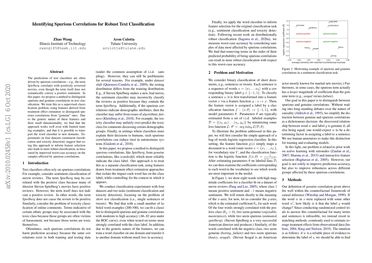Identifying Spurious Correlations for Robust Text Classification
The predictions of text classifiers are often driven by spurious correlations -- e.g., the term `Spielberg' correlates with positively reviewed movies, even though the term itself does not semantically convey a positive sentiment. In this paper, we propose a method to distinguish spurious and genuine correlations in text classification. We treat this as a supervised classification problem, using features derived from treatment effect estimators to distinguish spurious correlations from "genuine" ones. Due to the generic nature of these features and their small dimensionality, we find that the approach works well even with limited training examples, and that it is possible to transport the word classifier to new domains. Experiments on four datasets (sentiment classification and toxicity detection) suggest that using this approach to inform feature selection also leads to more robust classification, as measured by improved worst-case accuracy on the samples affected by spurious correlations.
PDF Abstract Findings of 2020 PDF Findings of 2020 Abstract




